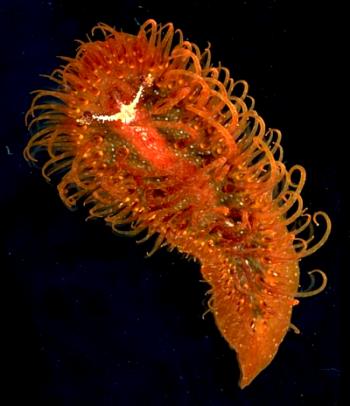
Madrella ferruginosa
Alder & Hancock, 1864
Order: NUDIBRANCHIA
Suborder: ARMININA
Family: Madrellidae
DISTRIBUTION
Tropical Indo-West Pacific
PHOTO
UPPER RIGHT: Lagoon between mainland and Récif de l'Infernet, off Koumac, New Caledonia, 20°34.4'S, 164°13'E, 12m, 4 October 1993, 42mm long alive, AM C200330
LOWER LEFT: N point of Île Nou, Nouméa, New Caledonia, October 1988, intertidal, on bryozoan, AM C156616.
LOWER RIGHT: Head and right side, showing shape of left rhinophore and dark basal gland at base of each ceras. Île Amédée, SW Lagoon, New Caledonia, 1m, October 1988, reef crest, under coral rock, AM C156658.
PHOTOS: Bill Rudman.
RELATED TOPIC
Grows to about 45mm. Very similar in shape to Madrella sanguinea but is a darker orange or red-brown colour and grows to a much larger size. Usually found on its food bryozoan. See page on M. sanguinea for a discussion of the two species. Both species have a gland at the base of each ceras [see photo below] which exudes a bright yellow or orange secretion, which is possibly derived from its bryozoan food.
Reference:
• Alder, J. & Hancock, A. (1864). Notice of a collection of nudibranchiate mollusca made in India by Walter Elliot Esq., with descriptions of several new genera and species. Transactions of the Zoological Society of London, 5: 113-147.
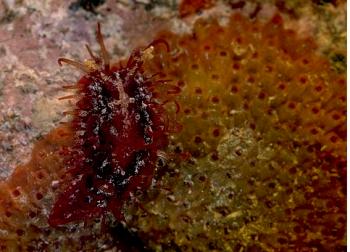
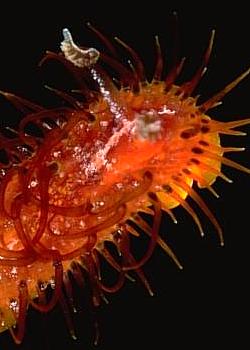
Rudman, W.B., 2001 (January 7) Madrella ferruginosa Alder & Hancock, 1864 . [In] Sea Slug Forum. Australian Museum, Sydney. Available from http://www.seaslugforum.net/find/madrferr
Related messages
Madrella ferruginosa from South Africa
September 18, 2007
From: Riaan Marx
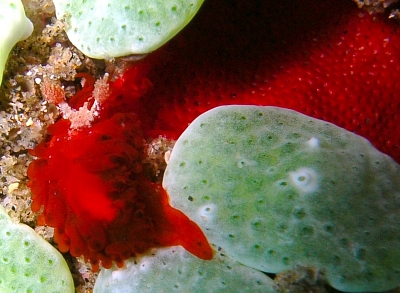
Hi Bill,
I made a preliminary ID on this critter of Madrella ferruginosa, but if it was not for the distribution and size I would have guessed it was M. sanguinea.
I see that since Valda's photo you have not yet posted another sighting of this species from South Africa, so I thought I'd send them on .... Also, in the second photo (it is the same individual) you can see the bryozoa I assume it is trying to get to.
Locality: Sodwana Bay, 18 metres, South Africa, Indian Ocean, 10 August 2007, Anton's Reef. Length: 20 mm. Photographer: Riaan Marx.
Kind regards
Riaan
riaan.marx@gmail.com
Marx, R., 2007 (Sep 18) Madrella ferruginosa from South Africa. [Message in] Sea Slug Forum. Australian Museum, Sydney. Available from http://www.seaslugforum.net/find/20704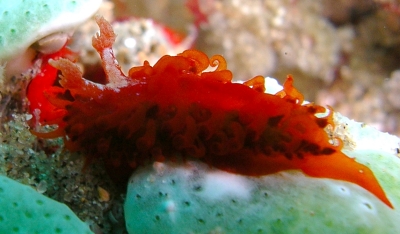
Dear Riaan,
Apart from smaller size and bright red colour pattern there is little in shape or anatomy to separate M. sanguinea from the larger and usually browner M. ferruginosa. However M. sanguinea, apparently restricted to south eastern Australia, is reported to have much larger eggs and directly developing larvae, while M. ferruginosa, with a wide Indo-West Pacific distribution has small planktonic larvae. These species seem to take up the pigment from their prey bryozoan which could explain why your animal is brighter red than usual for M. ferruginosa.
Best wishes,
Bill Rudman
Madrella ferruginosa from the Marshall Islands
August 24, 2007
From: Scott Johnson
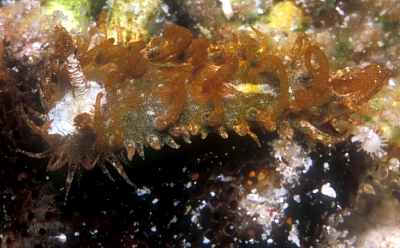
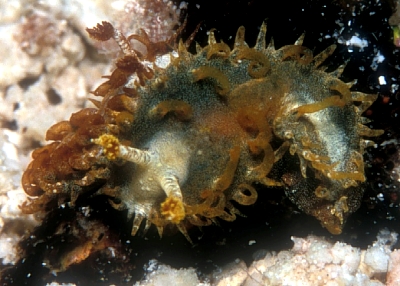
Hi Bill,
While reading Binyamin Koretz' recent message (#20270) on Madrella ferruginosa, I noticed that there are not yet too many records of it on the forum. The species occurs in the Marshall Islands, but for a long time I considered it quite rare. Until a few months ago, we'd found only two specimens in over 22 years of nudibranch hunting here. Recently, however, we started concentrating on the Halimeda algae habitat on our lagoon sandy slopes, and a fair number of rare species or new records for this area have been popping out. One of these is Madrella. For a couple of months, we could see as many as 10 specimens in an hour or so searching in the right places. Lately, though, they seem to have vanished. We have found none on our last few trips into the Halimeda. Curiously, we first saw egg masses just before most of the animals disappeared. (Egg mass photos are still being processed.)
Madrella is pretty easy to find when it is there. Running fingers through Halimeda clumps often causes them to fall out (although occasionally you end up with spines from small urchins in your fingers). Even if the nudibranchs do not dislodge from a Halimeda clump, disturbing them gives off quite an unmistakable cloud of yellow-orange fluid, as you note on the fact sheet. When you see that, a careful look through the algae always reveals one or more Madrella specimens.
Even though the animals have pretty much disappeared for now, it is probably temporary. Their food source, the dark-colored bryozoan under the animals in Jeanette's photos, grows abundantly within and around the bases of the Halimeda plants. The bryozoan, when damaged, gives off the same yellow-orange color as the nudibranchs.
Locality: Kwajalein Atoll, 8-12m, Marshall Islands, Pacific, 6 May 2007, Halimeda patch on sandy lagoon slope. Length: 14-18 mm. Photographer: Jeanette Johnson.
Scott Johnson
uwkwaj@yahoo.com
Johnson, S., 2007 (Aug 24) Madrella ferruginosa from the Marshall Islands. [Message in] Sea Slug Forum. Australian Museum, Sydney. Available from http://www.seaslugforum.net/find/20520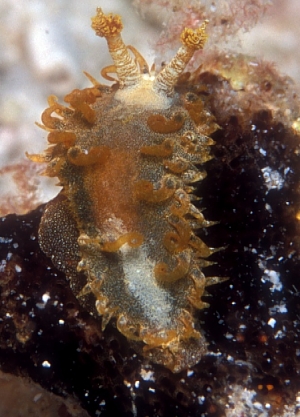
Thanks Scott,
I must check on the name of this bryozoan. I used to know it but at the moment it escapes me. The small bright orange spheres on the bryozoan colony are small embryos or larvae, which float away to settle elsewhere. I woyld be interested to see the egg photos when they are processed as it would give us an idea of its development type.
Best wishes,
Bill Rudman
Madrella ferruginosa from the Red Sea
July 31, 2007
From: Binyamin Koretz
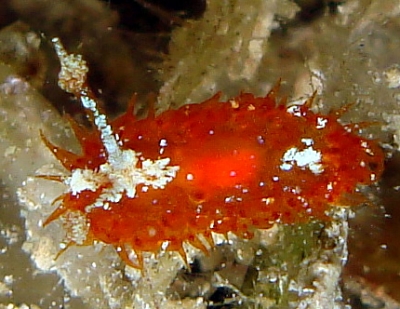
Hi Bill,
First time we've seen this, which we've identified as Madrella ferruginosa. I was a little jealous when I saw on the Forum that it grows to 45 mm -- our little guy was only 6 mm long.
Locality: Eilat, Satil Area, 23 m, Israel, Red Sea (Gulf of Eilat), 30 June 2007 (night), sea grass and patch reef. Length: 6 mm. Photographer: Binyamin and Shulamit Koretz.
Best regards
Binyamin
binyamin@koretz.net
Koretz, B., 2007 (Jul 31) Madrella ferruginosa from the Red Sea. [Message in] Sea Slug Forum. Australian Museum, Sydney. Available from http://www.seaslugforum.net/find/20270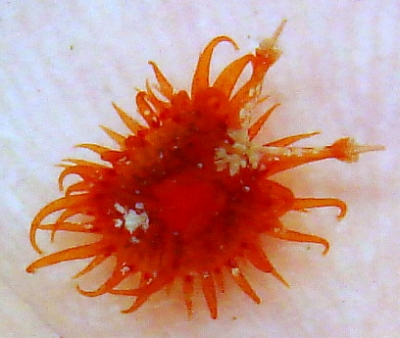
Dear Binyamin,
It's a nice find. I must say your smaller animal is a much brighter red than the large ones I have found in the Pacific, but I suspect that reflects the colour of the bryozoan they are feeding on rather than size.
Best wishes,
Bill Rudman
Madrella ferruginosa from Fremantle, Western Australia
February 20, 2007
From: Brent Murdoch
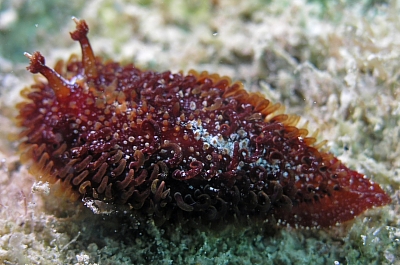
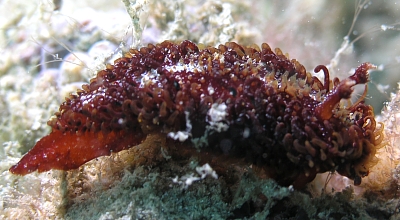
Hi Bill,
Can you please identify the attached. From the books I have I think it is a Madrella ferruginosa but the color is very dark. In its undisturbed state the "extra branchial appendages" are retracted, when disturbed they "fluff up" to
make it look twice the size. I have included a photo of this on my hand. Has
this been seen in the west before?
Locality: Fremantle, Swan River, 7.5, Western Australia, Indian, 05 February 2007, muddy. Length: 45 mm. Photographer: Brent Murdoch.
Brent Murdoch
brent@murdoch.id.au
Murdoch, B.D., 2007 (Feb 20) Madrella ferruginosa from Fremantle, Western Australia. [Message in] Sea Slug Forum. Australian Museum, Sydney. Available from http://www.seaslugforum.net/find/19498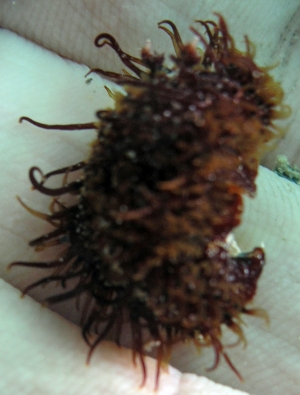
Dear Brent,
Yes this is M. ferruginosa. You will see on the Forum that there are photos showing animals as dark as yours. Most photos in books - and mine on the Fact Sheet - are brightly lit so we can see some detail. On the dark brown bryozoan the feed on they are almost invisible. The 'bristling' of the dorsal papillae that you describe is almost certainly a defensive behaviour. These animals don't have defensive cnidosacs, like the aeolids, but it is possible they have distasteful glandular secretions. They have a sac at the base of the papillae which can exude a yellowish secretion when they are disturbed. It seems to be based on waste fron the digestive system and so is most probably from their bryozoan food. Again, we don't know if it has a defensive purpose.
This species has been reported from southwestern Australia, but it has been misidentified as Madrella sanguinea, which is a smaller, bright red species, apparently endemic to southern Australia.
Best wishes,
Bill Rudman
Madrella ferruginosa from Japan
November 14, 2003
From: Yukari Sato
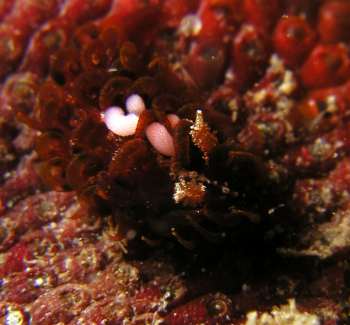
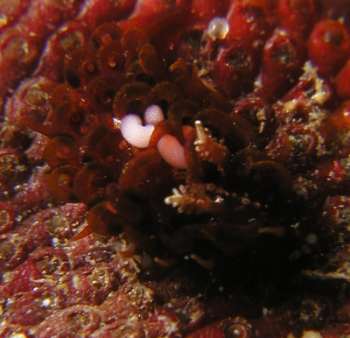
Hello Dr.Rudman,
I have found this animal at Izu, Japan.
I think this belong to the genus Madrella, but I do not know the species name.
Data:
Date:10,Oct,2003
Depth:3m
Size:8mm.
Loc:Futou, Suruga bay west coast of Izu peninsula,Japan
Best regards,
Yukari Sato
yuks@cg7.so-net.ne.jp
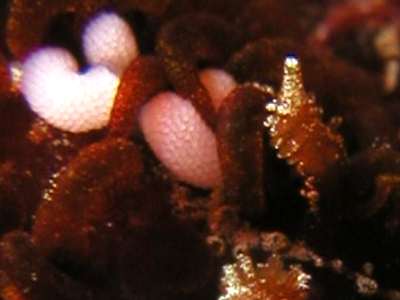
Dear Yukari,
This is indeed a Madrella, almost certainly Madrella ferruginosa. It is very difficult to photograph in situ as it is so well camouflaged against its bryozoan prey. An interesting feature of your animal are the white sausage-shaped objects on the back of the animal. In the close-up alongside you can see that they are a collection of tiny spheres and are in fact the egg masses of a parasitic copepod which must have taken up residence on the Madrella
Best wishes
Bill Rudman
Madrella ferruginosa from South Africa
January 9, 2001
From: Valda Fraser
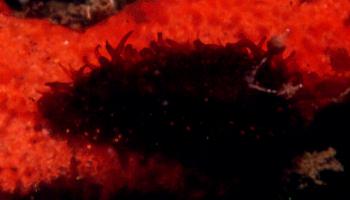
Dear Bill
Such a cute creature ... but what a devil to photgraph! Unfortunately this is the best that I could do. I think it is perhaps Madrella ?. When I tried to move it, a mustard coloured fluid came out of it and it stained my fingers.
Locality: Sodwana, north coast KwaZulu-Natal, SOUTH AFRICA, 15m
Date: Nov 2000
Size: 12mm
Regards
Valda Fraser
valdafraser@mweb.co.za
Fraser, V., 2001 (Jan 9) Madrella ferruginosa from South Africa. [Message in] Sea Slug Forum. Australian Museum, Sydney. Available from http://www.seaslugforum.net/find/3328Dear Valda,
Yes this is indeed a Madrella, probably Madrella ferruginosa. There is an interesting puzzle surrounding the large brownish tropical form and a bright red fprm from southern Australia which is named Madrella sanguinea. There is very little anatomically to separate the two and it will probably need a better understanding of the biology of the two to know whether they are two distinct species or not. If they prove the same then the name M. sanguinea is three months older than M. ferruginosa, both being named in 1864.
The yellow substance that dyed your fingers is exuded by glands or sacs at the base of each ceras. Both species produce this substance which is probably from the bryozoans they feed on. And yes they are very difficult to photograph.
Best wishes,
Bill Rudman.
